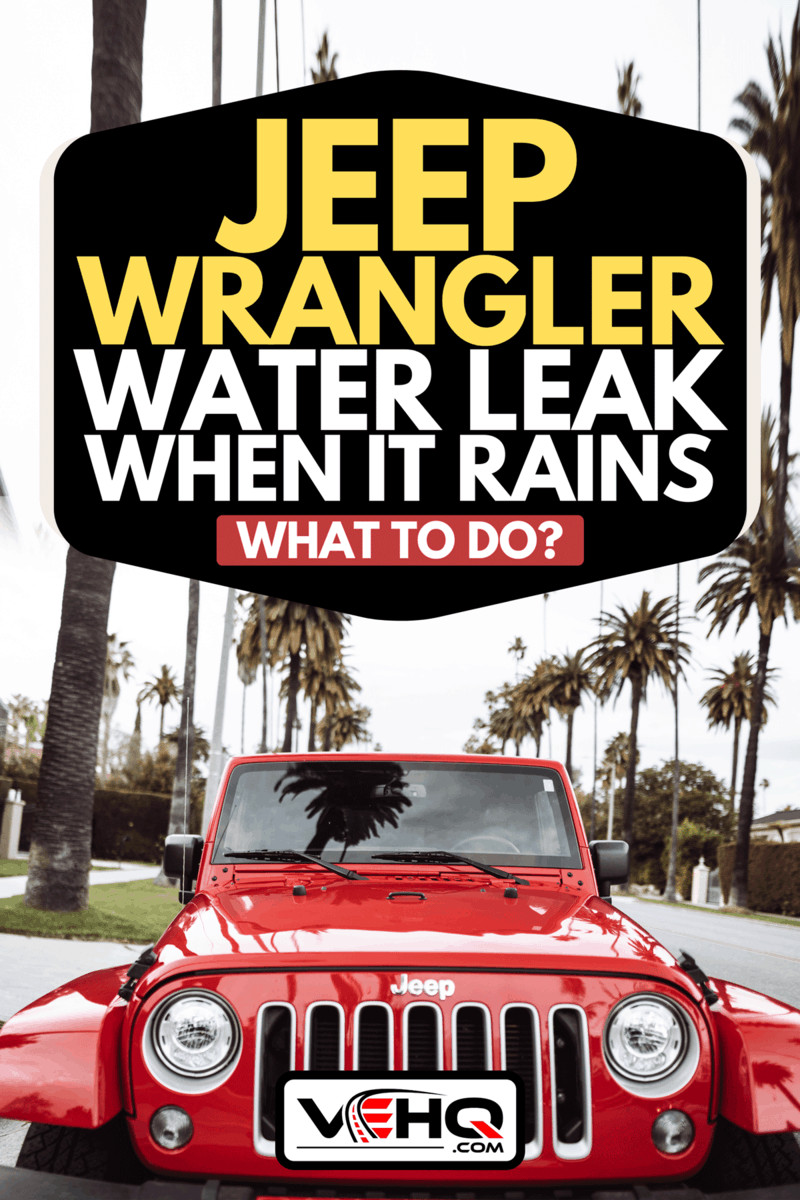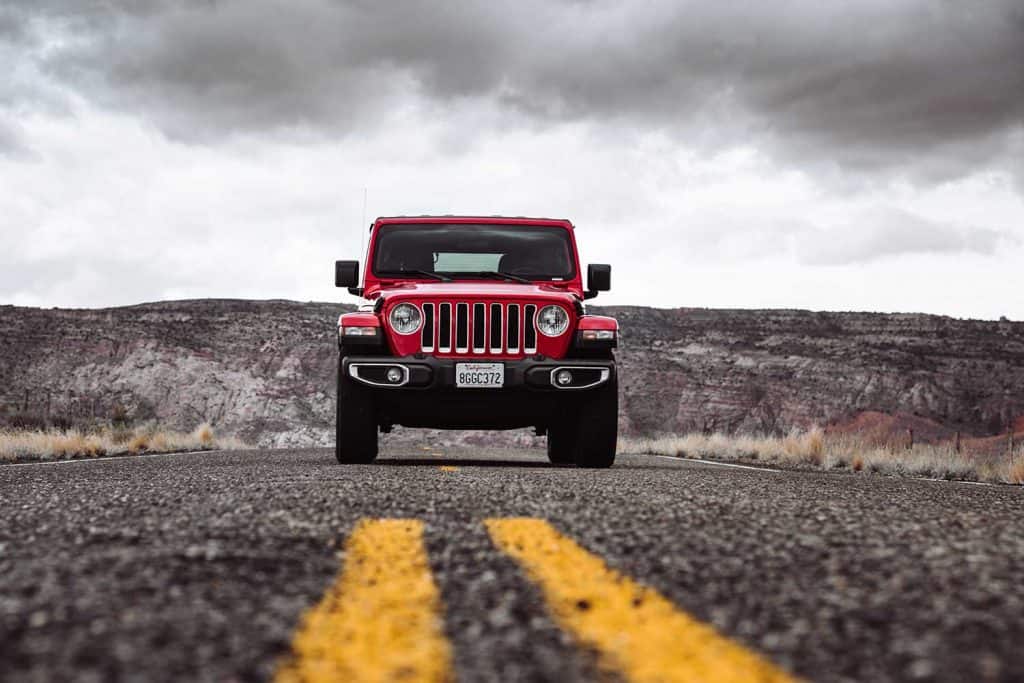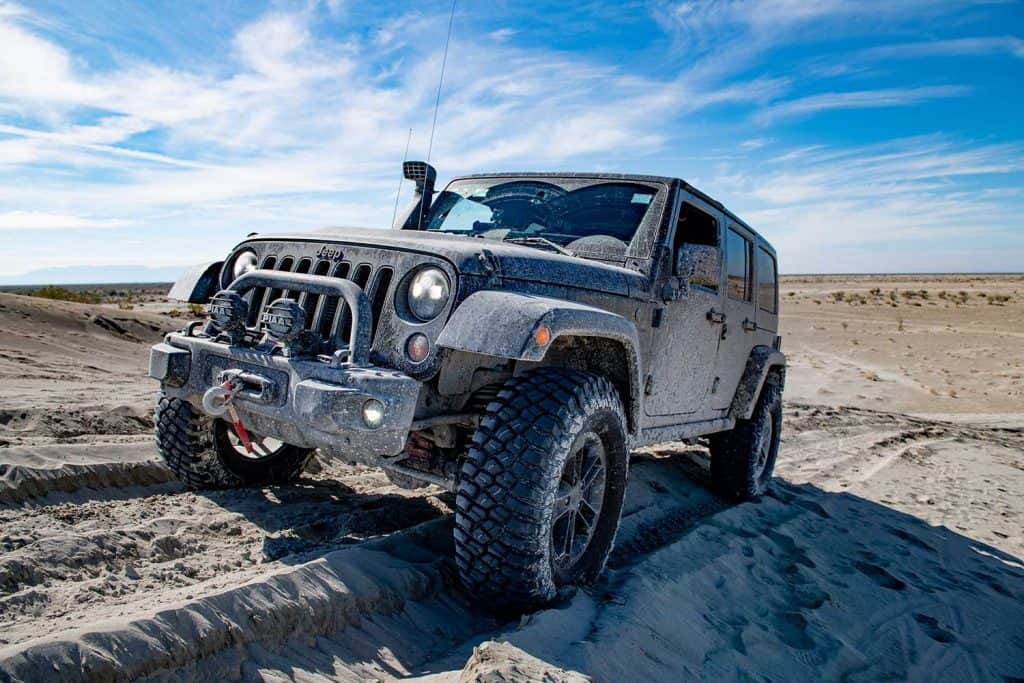You might have become aware of that dreaded musty smell when you open your Jeep Wrangler's door at the start of a trip. Or maybe you're driving in the rain and one of your passengers exclaims that they're getting wet. Either way, you now know that your beloved Wrangler is taking in a bit of water every time it pours from the sky. What do you do? We've researched how to combat this issue.
Your Jeep Wrangler could be leaking rainwater for one of several reasons. We've listed the most common places that have been known to leak water below:
- Windshield header seal
- Door fit
- A-pillar
- Freedom panel
Leaks can be a real irritation and could lead to long term damage to your Jeep Wrangler over time. While we were researching these methods, we also were able to answer some other common questions about the Jeep Wrangler. Do the hardtops leak? Do Jeep Wranglers have drain plugs? Is it ok to hose down the inside of your Jeep Wrangler? If you have a soft top, is going through a car wash safe? For the answers to these questions and more, keep reading!

Fixing the most common leaks in your Jeep

While this post doesn't cover absolutely every possible cause for a leak in your Wrangler, we will cover the most common. Continue reading to find out more about what they are and how to address them.
More than likely, you'll need to recreate the conditions that happen during the leak(s). Rather than wait around for a rainstorm, it's best to grab a garden hose and have someone hold it over the top of your Wrangler while you remain inside it, checking to see where the water is coming in.
Windshield header seal
Leaks on the driver's side door panel and/or on the instrument panel of your Jeep Wrangler will indicate that the leaking is most likely from a faulty windshield header seal. This is most common on Wranglers that are 2007 models or older, as later models have had much better header seals installed upon manufacturing.
To replace a faulty header seal:
- Remove the top of your Jeep to gain full access to the header seal.
- Remove the header seal by slowly peeling it away by hand. The adhesive that holds it in place will give way without any tools needed.
- Use a good adhesive cleaner to remove any residue. You'll want the area to be totally clean of gunk and debris.
- Apply butyl tape to the corner areas so that the new header seal can become affixed.
- Install the new rubber header seal, making sure it's sticking evenly to the butyl tape.
This video shows you the above steps, and is easy for someone inexperienced to follow:
Helpful Materials
Check out these products below to make this project easier.
Click here to see this adhesive remover on Amazon.
Click here to see this butyl tape on Amazon.
Door fit
Leaks that result in water collecting on your floorboard near your doors may indicate leaks along your door fit. This is usually a quick and inexpensive fix.
Grab some sponge window seal from your local automotive store and run it completely around the interior door trim. Press firmly to make sure it's in place properly. This should take care of leaks from your door fit.
Here's a video of one Jeep Wrangler owner showing how he was successful in using this method:
A-pillar
Your Jeep's A-pillar is located at the top front of your door frames where the doors meet the frame. Leaking from this spot on your Jeep Wrangler is probably the most common spot that owners report rain leaks from.
Fixing this is just a simple as fixing leaks from your door fit. Using an adhesive window seal that's available at your local automotive store, you can easily stop the leaking. Apply the adhesive stripping along the A-pillar evenly, pressing firmly on it after it's applied to ensure that it's sticking to the pillar.
This Jeep owner shows how he fixed his A-pillar leaks in this video:
Freedom panel
The freedom panels are panels that are attached to the hardtop of your Jeep and are above the driver and passenger seats. If you're getting water in through here, it's usually because they aren't seated properly. Should this not be the issue, the leaking can be easily resolved by applying a layer of 4mm butyl tape along the grooves that are in between the panels. Press this tape firmly into place, then replace your freedom panels.
Do Jeep hardtops leak?
Jeep hardtops have been known to leak, but it's almost always a problem with how they were put back on by the user. Not properly seating the hardtop (or inadvertently damaging the seals) is usually the reason. If your Jeep is letting in water where your hardtop seals, it's recommended that you remove the hardtop, check the rubber seals to make sure they aren't damaged, then replace the hardtop. Make certain that it's fastened down tightly.
Click here to see this seal kit on Amazon.
Do Jeep Wranglers have drain plugs (and where they're located)?
Driving a Jeep through high water or in rain with the top down will obviously allow water to begin to accumulate inside the Jeep's cab. Standing water inside a vehicle leads to molding and mildew and creates a lot of condensation that can ultimately damage your Wrangler's instrument panel. So if you've been off-roading in the rain with your freedom panels off, how do you remove the water from the floor of your Wrangler?
You'll be happy to know that all Jeeps come equipped with drain plugs. While many model Jeeps only have two, the Jeep JL Wrangler has four. These drain plugs are concealed beneath the seats; one under the driver's seat, one under the front passenger seat, and one under each back seat.
The JK model Wrangler has even more drain plugs. There are two in front of each seat in the front, and four in the back.
You'll need to remove the carpeting from the Wrangler to gain access to the drain plugs. Doing this is easy, as they just lift up off the floor of the Jeep. You'll also be able to easily remove the plugs by hand. If you get one that's stubbornly fixed in its drain hole, a blade of a pocket knife can do the trick.
Can you hose down the inside of a Jeep?

If you've taken your Jeep Wrangler on some off-road adventures, you've probably had the inside covered with dirt and mud. Fortunately, Jeeps aren't like cars, in that you'd need to break out the shop vac and carpet shampooer to get rid of the evidence.
If you remove the carpeting and drain plugs, you'll find that you can quickly and easily wash the inside of your Jeep with a hose. While Jeep's tout themselves as being strongly water resistant, they aren't waterproof. So be mindful of your Jeep's dash and on-board electrical systems. They are wired in such a way that they can take some splashes, but you would never want to turn the hose on them. Any mud on your instrument panel is best taken care of by simply wiping it off with a damp cloth.
Spray the floor of your Jeep Wrangler until the muddy water runs clear out of the drain holes. On a sunny day, leaving the top off will allow for your Wrangler to dry quickly. Later, reinsert the drain hole plugs and affix the carpeting and you're all set.
Can you take your soft-top Jeep through the car wash?
It's not advised to take your soft-top Jeep through a car wash. The myriad of chemicals will damage the non-glass windows, giving them a foggy appearance and rendering them useless. The brushes from the car wash will also damage the soft top.
It's best to hand wash the soft-top of your Jeep with soap and warm water. It might take a little longer, but you'll be keeping the soft-top in better condition for years to come.
How do you dry your Jeep Wrangler's carpet?
Unlike carpets in a car or truck, Jeep carpets can hold a TON of water. Not allowing them to dry will allow them to mildew, and that's not a fun smell to try to rid your Wrangler of.
If your carpets get wet, they should be removed as soon as possible. Removal is very simple, and doesn't require any tools; just lift and they're out.
Now that the carpets are out, you'll want to remove the drain plugs so that any excess water can drain out of your Wrangler. Otherwise, your carpets will just start to soak up more water when you put them back on your floorboards.
It's recommended that you don't lay the carpeting flat to dry. They retain a lot more water than you might think, and a flat drying method will take far too long. It's best to hang them up to dry so that the water they've soaked up can drip out of them.
When the carpets are dry to the touch, pop your drain plugs back in and place the carpeting back on the floorboards.
How do you dry your Jeep seats?
Jeep seats are known for being very water-resistant, even the ones made from cloth. Most Jeep Wrangler owners prefer to dry them out naturally by removing the top of the Jeep and parking somewhere that gets direct sunlight. After an hour or so, the seats should be dry.
But if you're in a hurry, a shop vac will do the trick.
In Closing
Jeep Wranglers are a fun way to explore rugged terrain and will give you the opportunity to take a vehicle to places that you wouldn't be able to drive a car to. This type of off-roading will get you and your Jeep drenched with water and mud, but we've learned that cleaning up the mess from your fun is a lot easier than it looks.
If you'd like to learn more about the Jeep Wrangler, we think you might get some great information from these posts:



